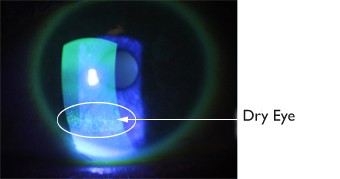
Is Laser Eye Surgery Safe?
Centre for Sight are proud to be a tertiary referral centre for patients who have complex problems, including problems following laser eye surgery. The two main reasons why patients come to see us who have had laser eye surgery elsewhere are 1) Dry eye and 2) Glare / Halos.
Both problems can be avoided by a thorough consultant led preoperative evaluation, surgical plan and in the case of dry eye, adequate treatment before the procedure. Bad dry eye results in staining of the cornea and this results in discomfort and poor vision.

A Mother Watches Her Daughter’s Surgery…
There are two broad categories of dry eye:
- Poor production – Poor production is often seen in contact lens wearers where tear production is down-regulated (slowed down). This can cause problems after laser eye surgery, and when identified in advance can be well managed. There are numerous other causes of reduced production from hormonal changes, side effects of medicines through to autoimmune diseases like Rheumatoid arthritis and Sjogren’s. The test to assess poor production is the Schirmer’s test where strips of blotting paper are placed just within the eyelids at the side and the length of the strip that becomes wet at 5 minutes is measured. Read more about Dry eye here.
- Increased evaporation – Increased evaporation is measured by the “Tear Break Up Time test”. Fluroscein dye is placed in the eye and after a blink the time it takes for tears to evaporate is measured. Tears should take 10 seconds or longer to break up. Increased evaporation occurs because one component of tears, the lipid or oily layer is deficient. Lipids come from the meibomian glands located in the lids. These should produce oils that are clear which mix with tears and decrease evaporation.

Meibomian gland disease is becoming very common and while there are many postulated causes, a major reason is felt to be a deficiency in Omega 3 in the modern diet. A good solution is now fortunately available – Omega eye is a ‘designer’ Omega 3 supplement that has been re-engineered to be more absorbable by the human body. Therapeutic doses are helpful in improving Meibomian gland disease and dysfunction. Find out more about Omega eye here.
I shall discuss Halos and strategies employed at Centre for Sight to avoid this problem in our next issue”.

Author Information
Authored by Sheraz Daya MD FACP FACS FRCS(Ed) FRCOphth, Consultant Ophthalmic Surgeon & Medical Director, June 2019.
